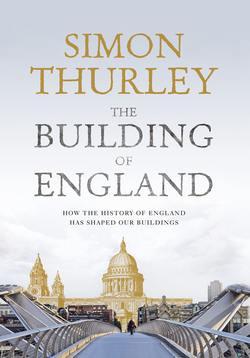Читать книгу The Building of England: How the History of England Has Shaped Our Buildings - Simon Thurley - Страница 14
Оглавление
| By 1000 it was not only England that existed but also a sense of Englishness among its inhabitants. |
| Introduction |
| Before the 10th century England was divided into numbers of small kingdoms that fluctuated in size and influence (fig. 12). Crudely speaking, in the years around 600, the kingdom of Kent was the most powerful of these; in the following century Northumbria was in the lead, and from about 700 Mercia was in the ascendant. Then from 865 until 954 everything was dominated by Scandinavian raiders – the Vikings who at first pillaged and then settled in the north and east. The problems caused by Viking aggression were only resolved by the royal dynasty of Wessex: King Alfred the Great (871–99), his son Edward the Elder (899–924) and his grandson Athelstan (924–39). In 927 Athelstan became the first true king of England, a position he secured with a series of decisive military victories and carefully planned treaties and alliances (fig. 12). |
| The success of the line of Alfred in uniting England owed much to the struggle against the Vikings. The imperative for defence and buying off the Vikings with cash payments stimulated the mobilisation of manpower on a large scale and the amassing of portable wealth by kings, both vital factors in the development of England and its architecture. Yet the Vikings themselves made little or no lasting contribution to England’s architecture.1 What foreign influences there were came from a much more powerful cultural source – the revival of the Roman Empire in Western Europe. |
| This revival was political, religious and, ultimately, architectural. Most important politically was the emergence, under Charlemagne (768–814), of a new empire that rivalled, in wealth, organisation and stability, the fallen empire of Rome. Its territories stretched from central Germany to northern Spain and into northern Italy. On Christmas Day 800, at the hands of Pope Leo III, Charlemagne took the title of Emperor of the Romans. This political revival was accompanied by a renewal of the authority and traditions of the Roman Church. In the 750s the Franks adopted the Roman liturgy to replace their Gallic forms; in 779 the payment of tithes to the church was enforced; in 789 all monastic orders were required to conform to the rules of St Benedict; and in 801 it was ordered that altars not containing relics should be demolished, stimulating a huge market in relics primarily from Rome. This represented not some generalised revival, but rather a self-conscious attempt to re-create the Emperor Constantine’s heroic age of Christianity. |
| Fig. 12 Anglo-Saxon England, showing the approximate location of the kingdoms, towns, coastal trading settlements (wics), places mentioned in the text and places that were attacked by the Vikings before 865. |
| The political and religious revival of late Rome was accompanied by an architectural one. Under Charlemagne’s influence his territories enjoyed one of the most important and creative periods of architectural development in European history. In his reign alone 16 cathedrals and 232 monasteries were either founded or rebuilt, establishing most of the key components of medieval ecclesiastical design. The style in which these features developed was that of early Christian Rome, epitomised by the basilicas of St Peter and St Paul; a way of building known as the Romanesque. Romanesque is, in fact, not so much a style as an aesthetic programme, the name given to a variety of effects used by architects to re-create more closely and effectively the architecture of ancient Rome. It became possible to do this through advances in building technology, materials and engineering that were stimulated, in their turn, by the peace and prosperity of Carolingian rule. All these developments were important for England.2 |
Fig. 13 Offa’s Dyke, Clun, Shropshire, a massive piece of military engineering begun soon after 757. It stretched from sea to sea, and for 200 years kept the marauding Welsh out of Mercian England.
